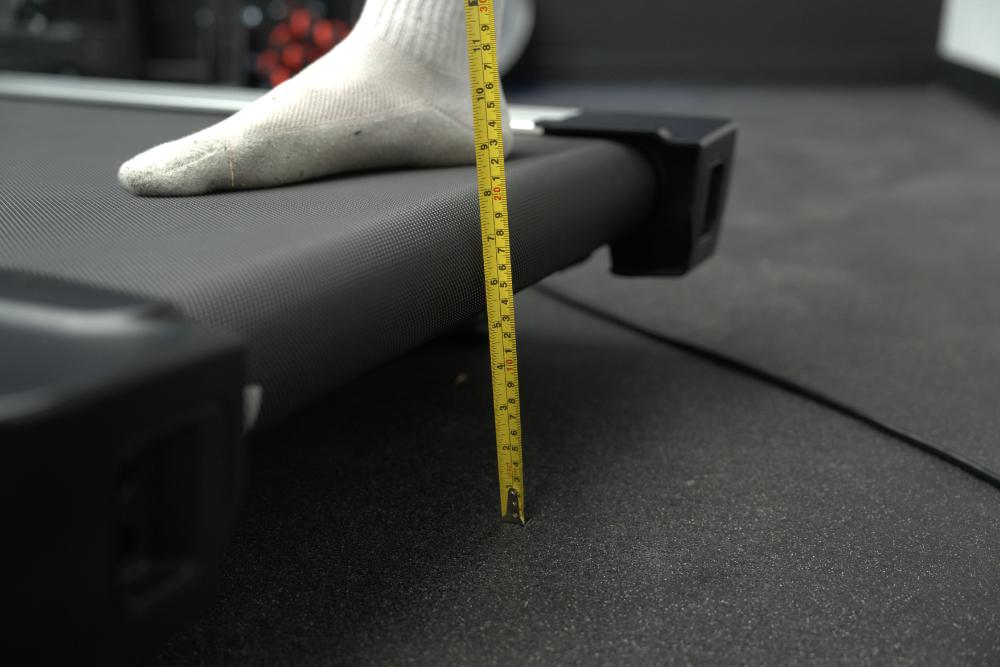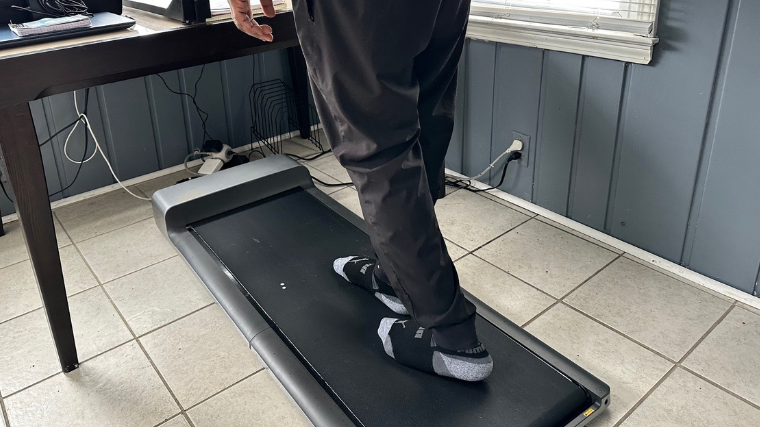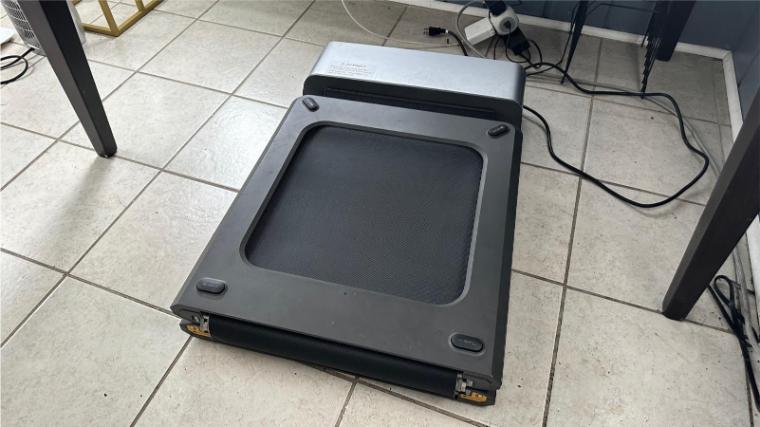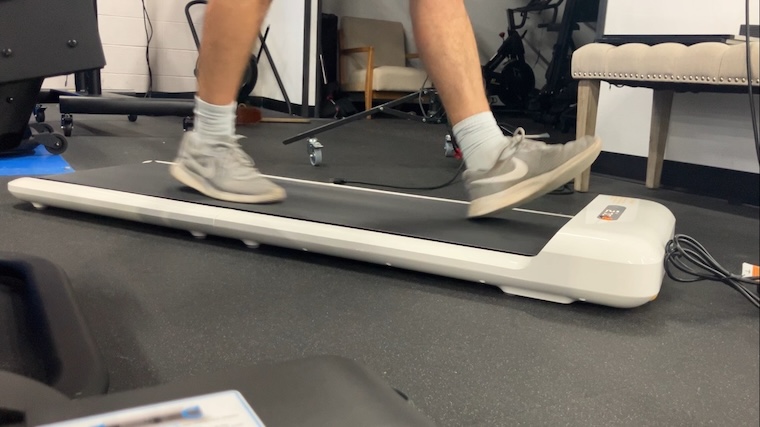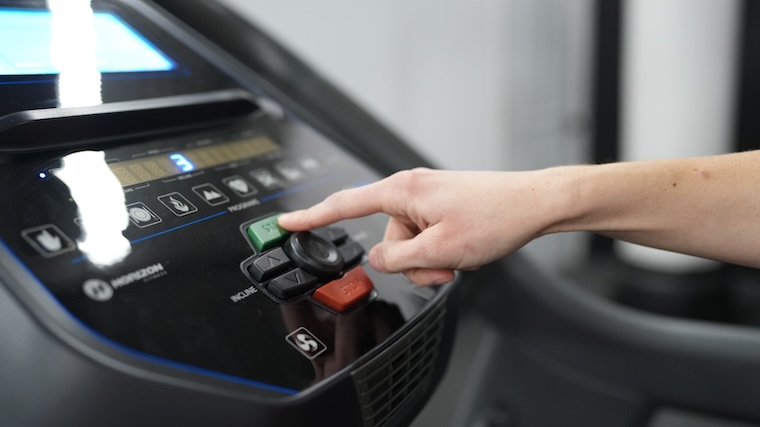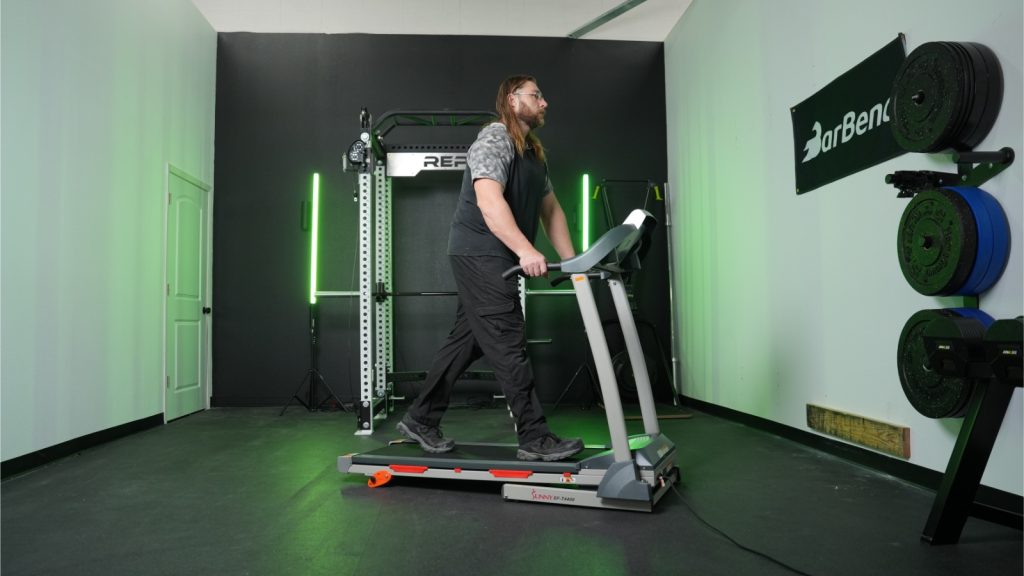Running on a treadmill can be taxing on your joints, and if you’re dealing with knee discomfort, odds are you’re going to be hesitant to hop onto one of these cardio machines for a worthwhile session. Thankfully, running on a treadmill with bad knees doesn’t need to be a challenging, painful experience. Plenty of the best treadmills have comfortable, well-cushioned running decks — as well as other accommodating components — to help you ease back into training at your full potential.
Finding an ideal treadmill for bad knees can be a different endeavor than searching for a top-performing treadmill overall. As our team of BarBend experts (including athletes and personal trainers) tested more than 45 treadmills, we kept a close eye on the most comfortable, cushioned machines for sensitive knees. To save you some trial and error (and keep your knees happy), we’ve gathered all the best treadmills for bad knees.
The 6 Best Treadmills for Bad Knees of 2025
- Best Treadmill for Bad Knees Overall: NordicTrack Commercial 1750
- Best Cushioned Treadmill for Bad Knees: Sole TT8
- Best Walking Treadmill for Bad Knees: WalkingPad P1
- Best Budget Treadmill for Bad Knees: Horizon 7.4 AT
- Best Running Treadmill for Bad Knees: Echelon Stride-4S
- Best Budget Treadmill for Bad Knees: Sunny Health & Fitness SF-T4400
Best Treadmill for Bad Knees Overall: NordicTrack Commercial 1750

The NordicTrack Commercial 1750 is made for the tech-loving runner. This high-tech treadmill features a touchscreen monitor that can tilt and rotate, and offers automatic incline, decline, and speed adjustments based on the workout you choose.
Specs
- Price: $2,499
- Max Incline: 12% incline, -3% decline
- Max Speed: 12mph
- Weight Capacity: 300lbs
- Product Dimensions: 80” L x 38” W x 65” H
- Motor: 3.5 CHP motor
Our team holds the Commercial 1750 in high regard, but this model — one of the best commercial treadmills, in our opinion — is no one-trick pony. We admire its effectiveness for athletes with bad knees thanks to its impressive RunFlex cushioning technology. We gave this machine an overall 4.5 out of 5 after rigorous testing.
“This machine felt incredibly sturdy,” our tester said, scoring the durability a 5 out of 5. “I do weigh less than the capacity but even running at the max speed, I didn’t feel the machine was shaky at all.” Our testers specifically enjoyed the supple landing in each stride during testing, which lessened the impact felt across our joints.
We score the customization options a 5 out of 5, as this machine goes to a negative 3% decline all the way up to a 15% incline, which is more than you’ll find with most treadmills.
Of course, it’s hard to recommend a NordicTrack treadmill without mentioning the iFIT‘s library of online training classes and challenges. Earning a 5 out of 5 for tech capabilities, this platform is among our favorites with its seemingly endless variety of workouts and programs. However, you do need to pay for access to the platform after a 30-day trial period. Some athletes may not love this additional charge but we’re big fans of iFIT over at BarBend.
The Commercial 1750 also features a rotating 14-inch touchscreen, which our tester appreciated when mixing on-treadmill and off-treadmill workouts within their respective regimen.
When it comes to overall value, we couldn’t help but give the 1750 a perfect 5 out of 5. “This machine does have a slightly higher price than you’ll see with other models but I feel that you get all of the comforts of a top-of-the-line treadmill,” our tester said.
Read our full NordicTrack Commercial 1750 Review.
Best Cushioned Treadmill for Bad Knees: Sole TT8

This heavy-duty treadmill features a steel framework with a 4.0 HP motor and a weight limit of 400 pounds. The three-inch rollers are ideal for runners, and the combination of incline and decline settings allows for hill work.
Specs
- Price: $2,899.99
- Max Incline: 15% incline, -6% decline
- Max Speed: 12mph
- Weight Capacity: 400lbs
- Product Dimensions: 82.5″ L x 38″ W x 66″ H
- Motor: 4.0 HP motor
After running a few miles on the Sole TT8, we found it to have one of the most comfortable running decks we’ve tested. According to our tester, the TT8’s two-ply belt and Cushion Flex Whisper technology help to make every stride feel as if we were running on clouds. These components are designed to help reduce impact by up to 40% across your joints, making it an easy pick for our best cushioned treadmill.
In addition to its comfortable running surface, we enjoyed the various settings available with this Sole treadmill, giving the customization a 5 out of 5. The max speed of 12 miles per hour and 15% max incline provided our tester with plenty of opportunities to mix up their intensity during workouts. The ability to train on a decline can be great for athletes dealing with joint issues, as regular decline training may help improve balance and knee strength. (2)
The Sole TT8 is also plenty durable thanks to its reinforced framework, which is rated for athletes up to 400 pounds, making it one of the best treadmills for heavy people we’ve tested. “Durability is no issue with this machine and it’s hard to find other comparable models,” our tester said, giving this category a 5 out of 5.
Plus, Sole backs up this impressive profile with lifetime coverage for the frame and motor, along with three years of support for the deck, parts, and wear items. One-year labor coverage is also included with the expansive warranty package, which can do a lot in offsetting the higher price tag.
Unfortunately, though, we had to give the footprint a 3 out of 5. The machine takes up 21.77 square feet of space and it weighs over 300 pounds, so we wouldn’t recommend moving this model around a lot. “When we move this treadmill at the warehouse we have to use a car jack and car dollies to push it around,” our tester notes, adding that the TT8’s lack of folding capabilities make it that much harder to move.
The price point is also a bit higher than the other models on this list at $2,699.99. We gave this factor a 3.5 out of 5, as it’s probably out of many athletes’ budgets. That being said, if you can swing it and really want a cushioned machine, you’ll be hard-pressed to find a match like this one.
Read our full Sole TT8 Review.
Best Walking Treadmill for Bad Knees: WalkingPad P1

This WalkingPad is among the most convenient for those who prioritize their daily steps. This foldable treadmill sits flat and can fit right under your desk.
Specs
- Price: $499
- Max Incline: N/A
- Max Speed: 3.75mph
- Weight Capacity: 220lbs
- Product Dimensions: 56.37″ L x 21.5″ W x 5″ H
- Motor: Brush motor
We understand if your nagging knees are so discomforting that you can’t muster up the energy for a full-blown run every day. If you’re looking to support your joint health with a daily dose of walking, though, we recommend the impressive WalkingPad P1, one of the best under-desk treadmills we’ve tested.
“After using this machine each day for 10- to 15-minute walks, I enjoyed the experience,” our tester, a certified personal trainer, says, giving the WalkingPad P1 an overall 4 out of 5 for workout experience. “The top speed isn’t very high, but it’s plenty for walking sessions.”
This machine has four-layer cushioning to help minimize the joint impact while completing your daily steps. However, our team did give this treadmill a 3.5 out of 5 for customizations. There are no incline or decline options and, as mentioned, the top speed is pretty low, as is the 220-pound weight capacity.
“I’m actually pretty surprised by the durability of this machine, though,” our tester says, giving this category a 4 out of 5. “After owning my WalkingPad for a year and a half, I’ve had no issue with it breaking down in any way.”
When it comes to footprint and portability — 4.5 out of 5 from our tester — it’s tough to match the WalkingPad P1 or similarly-designed C2 model that BarBend editorial member Matt Cummings tested out. “WalkingPad treadmills just fold right in half, so to move it around, I simply lifted it up and set it back down,” he says. “I wish there was some kind of handle to make that easier, but just grabbing the frame wasn’t difficult, either.”
Along with the remote control, both models can use WalkingPad’s unique FootSense Technology to adjust speed. “I was very skeptical about how responsive the FootSense Technology would be, but after getting the hang of it, I preferred it to the manual mode,” he says. “When I walked closer to the front of the belt, it sped up smoothly, then the opposite for the rear of the belt.”
The WalkingPad P1, one of the best walking treadmills you’re likely to find, is pretty cost-friendly at $499 — and is often on sale for under $400 — earning it a 4 out of 5 for overall value. However our tester did have some issues with the remote. A little after a year of owning the machine, the remote completely stopped working, which is a bummer because it’s how you control the machine. Luckily, the app still works and has the same capabilities but we still would have liked to see some more longevity there.
Read our full WalkingPad Review.
Best Treadmill for Bad Knees with Streaming: Horizon 7.4 AT

The Horizon 7.4 AT treadmill is ideal for anyone who likes to stream fitness classes throughout their workout. In addition to Bluetooth connectivity for streaming, this tread also features 3-zone variable response cushioning and feather-light folding to make storing this treadmill seamless.
Specs
- Price: $2,399
- Max Incline: 15%
- Max Speed: 12mph
- Weight Capacity: 325lbs
- Product Dimensions: 76″ L x 37″ W x 63″ H
- Motor: RapidSync
Training with bad knees can be painful in its own right, but training on a machine with zero tech options? That’s a different kind of pain. Luckily, the Horizon 7.4 AT connects to all your favorite third-party apps via Bluetooth to allow you to enjoy workouts with the help of apps like Peloton and Zwift. We give the 7.4 AT’s tech capabilities a 5 out of 5 — you do need to supply your own tablet or phone, but you can mount it on the machine’s device holder.
When it comes to adjustability and ergonomics, our testers give it a 4.5 out of 5. “You get quick-dial adjustments, which make customizing this machine so quick and easy,” they say. “You can also design your own workouts on the custom intervals program, which I liked.”
You shouldn’t come across any durability issues with the 7.4 AT. The max weight capacity is 325 pounds, which is pretty standard and our testers really enjoyed the sturdiness of the machine, giving this category a 4.5 out of 5. “The deck is cushioned and feels comfortable,” our tester said. “I do just wish there was a little less plastic on the machine.” That said, we don’t foresee any issues with breaking parts if you’re using it responsibly.
For overall value, we did have to knock the Horizon 7.4 AT a few points, giving it a 3.75 out of 5. This machine has a lot of bells and whistles but $2,399 is a lot to pay for a treadmill. If it’s within your price range and streamable content is a priority, definitely go for it.
Read our full Horizon 7.4 AT Treadmill Review.
Best Running Treadmill for Bad Knees: Echelon Stride 4S

The Echelon Stride-4s treadmill is among the most tech-friendly, for athletes who love to stream workouts while they exercise. This machine also has a soft, cushioned deck for sensitive knees.
Specs
- Price: $2,299.99
- Max Incline: 15% incline
- Max Speed: 12.4mph
- Weight Capacity: 325lbs
- Product Dimensions: 74″ L x 31″ W x 53″ H
- Motor: 3.0 CHP motor
Given the wide range of speeds and incline options, we think the Echelon Stride 4S is one of the best treadmills for running. When paired with the plush deck, it’s also a good choice for runners with sensitive knee joints. “The cushioning on the deck was plenty bouncy and comfortable. I’ve run on even more cushioned decks but this was a good one,” our tester says.
For durability, our tester gives the Echelon Stride 4S a 5 out of 5. Even at top speed, our team didn’t notice any shaking or movement. We also liked that the side beams are made of metal, rather than plastic, further contributing to the overall durability.
The tech capabilities for this treadmill earn a 3 out of 5. It comes equipped with a 22-inch touchscreen that has 180-degree rotation for off-treadmill workouts, too. You get access to Echelon’s wide library of workout videos where you can try new programs and track your progress. However, you do have to pay an additional monthly fee for membership. We also didn’t think you get quite as many workout options compared to other programs, such as iFIT and Peloton.
For portability and footprint, we gave this one a 4 out of 5. It does have wheels and a handle, making it easy to move around. You can also vertically fold the machine to clear up a bit of floor space when it’s not in use.
As a whole, we give this a 3.5 out of 5 for value. As a running treadmill for sensitive knees, we think it makes a good fit. But the technology does bump up the price tag to over $2,000 (though it’s often on sale for under $2,000, so keep an eye out).
Read our full Echelon Treadmills Review.
Best Budget Treadmill for Bad Knees: Sunny Health & Fitness SF-T4400

This Sunny Health & Fitness treadmill is a steal at less than $400. It goes up to high speeds and even has some incline capabilities at an ultra-low price.
Specs
- Price: $499.99
- Max Incline: 4.3% incline
- Max Speed: 9mph
- Weight Capacity: 220lbs
- Product Dimensions: 72” L x 25.5” W x 50” H
- Motor: 2.2 Peak HP motor
You don’t need to spend thousands of dollars for a good treadmill. In fact, you can get a pretty high-quality machine for just a couple hundred bucks. At only $499.99 (and often on sale), our team gives the Sunny Health & Fitness SF-T4400 an overall 5 out of 5 for value. The T4400 is among the best budget treadmills we’ve tested.
“This machine folds flat and could easily fit in a larger car, if needed,” our tester said, giving the portability a 5 out of 5. “I also liked the soft-drop folding feature because it’s actually quiet, the machine doesn’t slam on the ground.”
We did have to dock this machine a few points for durability, giving it a 3 out of 5. Realistically, we don’t expect this one to last for a few decades, but that’s to be expected when you’re paying less than a grand for a treadmill.
This treadmill doesn’t offer too much when it comes to customizations and adjustability, earning a 3.5 out of 5 and 3 out of 5 in each category, respectively. The incline adjustments must be made manually and the 220-pound weight capacity is around 80 pounds below the industry standard.
You also won’t want to expect much in the tech department. The LCD digital monitor can track your speed, time, distance, pulse, and calories, however it’s not compatible with fitness apps. Athletes who love virtual workout classes may want to opt for another machine.
Read our full Sunny Health & Fitness TF-4400 Treadmill Review.
How We Tested and Chose the Best Treadmills for Bad Knees
The BarBend team is made up of competitive athletes, certified personal trainers, and lifelong fitness enthusiasts. Over the years, we’ve put more than 50 treadmills to the test, utilizing the BarBend equipment testing methodology to score products on a scale of 1 (meh) to 5 (great!) in areas such as durability, adjustability, and value. Here are the factors we considered to build this list.
- Cushioning: We looked for treadmills with thick belts that could absorb impact better, a necessity for those who need to work around knee discomfort. While some brands list their treadmills’ belt thickness and makeup (one-ply vs. two-ply, etc.), others do not. We did our best to gather firsthand experience as much as possible when examining this factor.
- Running Deck Dimensions: We also looked at each treadmill’s listed running deck dimensions and tested their actual usability wherever possible. BarBend expert and certified personal trainer Amanda Capritto recommends a deck of 60 inches for running and 50 to 55 inches for walking and jogging — these dimensions can ensure you have plenty of room for your stride during workouts.
- Storage: Treadmills are some of the largest pieces of home gym equipment out there, so being able to conveniently house them when not in use is a plus for any athlete. We looked at how spacious each silhouette was when in operation, and whether the design featured any space-saving components such as a foldable running deck.
- Workout Experience: You’re already going into your treadmill session with discomfort and irritability — why enhance those feelings with a lack of training variety or other conveniences? We looked at how accommodating each treadmill was during workouts through a slew of categories. Was there an available app integration that allowed for versatile training? Were there conveniences like media and water bottle holders within reach? All played a part in our rankings.
Benefits of Treadmills for Bad Knees
As intimidating as it may seem, using a treadmill while dealing with knee discomfort can actually be a boost to your overall well-being. These feature-rich machines can be great for keeping active throughout the irritation while also supporting your physique for fewer aches and pains in the future.
- Comfort: “A treadmill with a cushioned deck provides comfort during exercise that can’t be found on pavement or trails,” explains BarBend expert reviewer Amanda Capritto, a certified personal trainer. “For people with bad knees, a cushioned treadmill might be the only option for participating in weight-bearing cardio exercise.”
- Improved Balance: Walking on a treadmill can also be a great way to improve your balance, according to studies. (2) Having a greater sense of balance in your daily life can help you prevent errant falls and unnecessary strain across your joints. This can be especially beneficial for older athletes as well. (3)
- Injury Prevention: Treadmills can be an excellent tool for strengthening the muscles around your knees. (1) “Walking on a incline is also beneficial for those with knee problems as it strengthens the legs and hips which can help reduce knee pressure and because of the stretch on the achilles and calves, it can help those with foot pain and injuries like plantar fascitis,” says BarBend expert and physical therapist Dr. Karena Wu. “This is also good for people who cannot tolerate high intensity activities.”
[Related: Best Treadmills for Seniors]
What to Consider When Buying a Treadmill for Bad Knees
If you have knee discomfort and want to elevate your training with a worthwhile treadmill, there are a few components to consider. Below are some factors we recommend looking into as you inquire about a treadmill for bad knees.
Running Deck
Most worthwhile running decks will measure 20 inches wide and 60 inches long. These are ideal dimensions, as they can cater to most walking and running strides. Shorter running platforms may be acceptable for walking, but they may be too confined for workouts at higher tempos. Taller athletes may also want to explore longer running decks — thankfully, we’ve rounded up some of the best treadmills for tall runners.

You also want to look at the actual makeup of your treadmill’s running deck, as this can impact your overall comfort during training. Thicker belts of two-ply and three-ply materials can be better at shock absorption, helping lessen the energy transfer you experience in your joints.
“While it is best to talk to a movement specialist, like a physical therapist, before beginning a new exercise routine, if you have injuries or joint conditions, you may be pleased to know there are still plenty of treadmills on the market that are able to ease joint pain commonly associated with walking and running,” according to Amanda Capritto, our expert and a certified personal trainer. “Some machines feature specially designed padding beneath the belt to absorb shock and reduce impact.”
Technology
Most quality machines, like those featured in this round-up, will be able to reach speeds up to 12 miles per hour, as well as inclines of up to 15%. You can also opt for a treadmill that supports decline settings, which may be a worthwhile discipline to explore when trying to strengthen your knees. Studies have indicated that regularly walking backwards at a decline can help improve your balance and stability, lending itself to stronger joints and musculature over regular practice. (2)
Roller Size
Your rollers dictate how efficient your treadmill belt moves in a single revolution. The larger the rollers are, the less energy your machine needs to turn that belt. This can help preserve the effectiveness and efficiency of your treadmill motor over time.
We’ve found that rollers over 2 inches in diameter can withstand extended use more than rollers of smaller stature. Some treadmills may feature 1.9-inch rollers, but oftentimes offset this technology with more durable, high-quality motors. Be sure to check out your treadmill’s technical specifications prior to purchase — if the rollers are smaller than 2 inches, make sure they’re supported by a well-built motor of at least 3 CHP (constant horsepower) to facilitate more rigorous use.
Price
Lastly, it’s important to consider the actual cost of treadmills when looking for an option that’s suitable for your bad knees or knee injuries. Prices can range from budget-friendly profiles under $1,000 to luxury silhouettes reaching five-figure totals.
Cheaper profiles may suit your budget more, but may not offer convenient features like integrated apps, streaming capabilities, and versatile speed and incline settings. Think about how much you’re willing to invest in your home gym layout before ultimately deciding on a profile.
How Much Do Treadmills for Bad Knees Cost?
Treadmills with the kind of cushioning that can ease the impact on your knees tend to cost more than $1,500, putting them on the upper end of the average cost for treadmills. We did, however, seek to include a budget option under $500 and a walking treadmill that can also help save you a bit of coin. See their price tags side by side in the below chart.
| Best Treadmill for Bad Knees Overall | NordicTrack Commercial 1750 | $2,499 |
| Best Cushioned Treadmill for Bad Knees | Sole TT8 | $2,899.99 |
| Best Walking Treadmill for Bad Knees | WalkingPad P1 | $499 |
| Best Budget Treadmill for Bad Knees | Horizon 7.4 AT | $2,399 |
| Best Running Treadmill for Bad Knees | Echelon Stride-4S | $2,299.99 |
| Best Budget Treadmill for Bad Knees | Sunny Health & Fitness SF-T4400 | $499.99 |
How to Use a Treadmill with Bad Knees
Because of your apparent joint discomfort, walking or running on a treadmill with bad knees is a little different than your normal, fully-healthy strides. After all, you don’t want to irritate your joints even further by pushing your limits too far in a given exercise. Below are a few quick tips to help ensure your training sessions remain as comfortable and efficient as possible.
Warm Up Before Training
Going into a treadmill session cold can be a prime opportunity for further joint aggravation. So, to help your knees ease into the workout, it’s important to warm up and stretch before your day’s training circuit.

Take roughly 10 to 15 minutes to get your body warmed up for your run or walk, and be sure to put some extra focus on activating your knees. This can be done in multiple fashions — from a full-blown dynamic warm-up to quick foam-rolling sessions, and more.
Avoid Excessive Inclines and Speeds
While some pitch moderation and uptempo pacing can be beneficial for strengthening bad knees, you don’t want to force your body into unnatural stances too quickly when dealing with discomfort. Inclines between 10% and 12% can be stressful across the joints more often than not, creating an added sense of strain that could stall your progress overall.
In terms of speed, your pace can impact your stride length as well as your impact on the platform itself. (6) You’ll be pushing off the running deck with more force (and subsequently landing in the same fashion) if you’re trying to keep up with a quicker speed setting. So, we recommend taking your workouts to a cruising pace at first, adjusting your tempo in tune with how you feel on a given day.
Wear Appropriate Footwear
You don’t need to solely rely on your treadmill’s running deck when it comes to creating a well-cushioned stride. A pair of the best running shoes can make just as much an impact (pun intended) when it comes to creating a comfortable training setup. Be sure to pair your cardio training to footwear that matches your gait with proper levels of support and stability.

It can also be helpful to go with running shoes featuring a comfortable upper and lacing structure. Finally, make sure there’s enough underfoot cushioning across the midsole to make every step as cozy as possible — you don’t want to have a rigid, brick-like sensation in your landings when trying to keep joint impact as low as possible.
Listen to Your Body
Finally, the one person that best understands how your knees feel in the throes of a workout is you. Whether you’re a beginner or experienced athlete, be sure to listen to your body before, during, and after your treadmill sessions, taking necessary breaks and pauses when necessary. Your knees will tell you when they’ve had enough and when they need a rest, so be sure to listen for these cues when trying to manage your pain and training schedule in tandem.
Treadmills for Bad Knees FAQs
Can you use a treadmill if you have bad knees?
Yes, you can still train with a treadmill if you suffer from knee discomfort, albeit with a few precautions. For one, training at a heightened incline can cause your knees to bend at a more unnatural angle, which can lead to further aggravation. The same can be said for working out at high intensities when dealing with nagging joints. The best way to use a treadmill with bad knees is by employing a proper warm-up before training, wearing the appropriate footwear, and setting the machine at a comfortable speed and incline.
What is the best incline on a treadmill for bad knees?
If you’re dealing with knee pain when walking or running, the best incline to set your treadmill is subjective. Be sure to find an appropriate pitch that keeps your joints comfortable with every stride. That said, researchers have found that operating a treadmill between inclines of 0% and 3% has shown to provide positive results. (4) This is due to the added stress placed on the glutes and hamstrings instead of the joint itself.
Which treadmill is best for bad knees?
The best treadmill for bad knees depends on a number of factors, including your budget, and fitness goals. In our opinion, the NordicTrack Commercial 1750 is the most ideal profile for athletes with bad knees thanks to its comfortable, well-cushioned deck and versatile range of speeds and inclines. We think it’s one of the best NordicTrack treadmills, and love that it’s compatible with the excellent iFIT app.
How do you protect your knees on a treadmill?
You can protect your knees and joints in a number of ways when taking part in a treadmill workout. One of the most beneficial precautions you can take is by employing a proper warm-up before the training even begins. This can get your joints and musculature active and firing before the stress begins to take hold. Additionally, wearing the proper running shoes with ample cushioning and support can help lessen the impact felt across the area during landings and takeoffs.
References
- Alghadir, A. H., Anwer, S., Sarkar, B., Paul, A. K., & Anwar, D. (2019, April 9). Effect of 6-week retro or forward walking program on pain, functional disability, quadriceps muscle strength, and performance in individuals with knee osteoarthritis: A randomized controlled trial (retro-walking trial) – BMC musculoskeletal disorders. BioMed Central. https://bmcmusculoskeletdisord.biomedcentral.com/articles/10.1186/s12891-019-2537-9
- Cha, H.-G., Kim, T.-H., & Kim, M.-K. (2016). Therapeutic efficacy of walking backward and forward on a slope in normal adults. Journal of Physical Therapy Science, 28(6), 1901–1903. https://www.ncbi.nlm.nih.gov/pmc/articles/PMC4932084/
- Pirouzi, S., Motealleh, A. R., Fallahzadeh, F., & Fallahzadeh, M. A. (2014, November). Effectiveness of treadmill training on balance control in elderly people: A randomized controlled clinical trial. Iranian journal of medical sciences. https://www.ncbi.nlm.nih.gov/pmc/articles/PMC4242992/
- Plancher, K. (2021, May 10). Protect your knees while running on the Treadmill. Plancher Orthopaedics & Sports Medicine. https://plancherortho.com/protect-your-knees-while-running-on-the-treadmill/
- Tarniţă, D., Petcu, A. I., & Dumitru, N. (2020). Influences of treadmill speed and incline angle on the kinematics of the normal, osteoarthritic and prosthetic human knee. Romanian Journal of Morphology and Embryology, 61(1), 199–208.
- van Oeveren, B. T., de Ruiter, C. J., Beek, P. J., & van Dieën, J. H. (2017). Optimal stride frequencies in running at different speeds. PLoS One, 12(10). https://www.ncbi.nlm.nih.gov/pmc/articles/PMC5653196/






